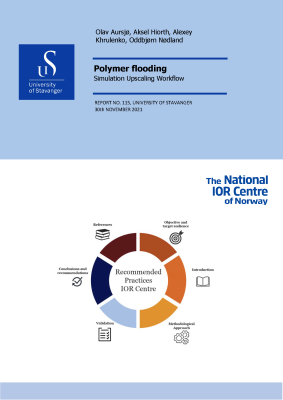Polymer flooding: Simulation Upscaling Workflow
Keywords:
The National IOR Centre of Norway, polymer flooding, fluid dynamicsSynopsis
There are many issues to consider when implementing polymer flooding offshore. On the practical side one must handle large volumes of polymer in a cost-efficient manner, and it is crucial that the injected polymer solutions maintain their desired rheological properties during transit from surface facilities and into the reservoir. On the other hand, to predict polymer flow in the reservoir, one must conduct simulations to find out which of the mechanisms observed at the pore and core scales are important for field behavior.
This report focuses on theoretical aspects relevant for upscaling of polymer flooding. To this end, several numerical tools have been developed. In principle, the range of length scales covered by these tools is extremely wide: from the nm (10-9 m) to the mm (10-3 m) range, all the way up to the m and km range. However, practical limitations require the use of other tools as well, as described in the following paragraphs.
The simulator BADChIMP is a pore-scale computational fluid dynamics (CFD) solver based on the Lattice Boltzmann method. At the pore scale, fluid flow is described by classical laws of nature. To a large extent, pore scale simulations can therefore be viewed as numerical experiments, and they have great potential to foster understanding of the detailed physics of polymer flooding. While valid across length scales, pore scale models require a high numerical resolution, and, subsequently, large computational resources.
To model laboratory experiments, the NIORC has, through project 1.1.1 DOUCS, developed IORCoreSim. This simulator includes a comprehensive model for polymer rheological behavior (Lohne A. , Stavland, Åsen, Aursjø, & Hiorth, 2021). The model is valid at all continuum scales; however, the simulator implementation is not able to handle very large field cases, only smaller sector scale systems. To capture polymer behavior at the full field scale, simulators designed for that specific purpose must be used.
One practical problem is therefore: How can we utilize the state-of-the-art polymer model, only found in IORCoreSim, as a tool to decrease the uncertainty in full field forecasts? To address this question, we suggest several strategies for how to combine different numerical tools. In the Methodological Approach section, we briefly discuss the more general issue of linking different scales and simulators. In the Validation section, we present two case studies demonstrating the proposed strategies and workflows.
References
https://doi.org/10.2118/942054-G
Brigham, W. (1974). Mixing Equations in Short Laboratory Cores. SPE J. 14 (01), 91-99.
https://doi.org/10.2118/4256-PA
Eikje, E., Nedrelid, T., Bratli, E., Kulkarni, R., Fylling, A. E., Lyse, O. A., & Aarrestad, H. D. (2020). Towards A Recovery Ambition Of "More Than 70%" For The Johan Sverdrup Field. paper presented at the Offshore Technology Conference, Houston, Texas, USA, May 2020.
https://doi.org/10.4043/30525-MS
Huggins, M. L. (1942). The viscosity of dilute solutions of long-chain molecules. IV. Dependence on concentration. Journal of the American Chemical Society, 64(11), 2716-2718.
https://doi.org/10.1021/ja01263a056
Jansen, J. D., Fonseca, R. M., Kahrobaei, S., Siraj, M. M., Van Essen, G. M., & Van den Hof, P. M. (2014). The Egg model - A geological ensemble for reservoir simulation. Geoscience Data Journal, 1(2), 192-195.
https://doi.org/10.1002/gdj3.21
Khrulenko, A. (2021). Translation of IORCoreSim polymer model into Eclipse. Report part of Project 2.7.1. Stavanger, Norway: The National IOR Centre of Norway.
Lantz, R. B. (1971). Quantitative evaluation of numerical diffusion (truncation error). Society of Petroleum Engineers Journal, 11(03), 315-320.
https://doi.org/10.2118/2811-PA
Li, Z., & Delshad, M. (2014). Development of an analytical injectivity model for non-Newtonian polymer solutions. SPE Journal, 19(03), 381-389.
https://doi.org/10.2118/163672-PA
Lohne, A. (2020). User's manual for IORCoreSim - combined EOR and SCAL simulator (Version 1.311). NORCE.
Lohne, A., Nødland, O., Stavland, A., & Hiorth, A. (2017). A model for non-Newtonian flow in porous media at different flow regimes. Comput Geosci 21, 1289-1312.
https://doi.org/10.1007/s10596-017-9692-6
Lohne, A., Stavland, A., & Reichenbach-Klinke, R. (Vol. 2019, No. 1). Modeling of Associative Polymer Flow in Porous Medium. IOR 2019-20th European Symposium on Improved Oil Recovery (pp. 1-28). European Association of Geoscientists & Engineers.
https://doi.org/10.3997/2214-4609.201900117
Lohne, A., Stavland, A., Åsen, S. M., Aursjø, O., & Hiorth, A. (2021). Recommended polymer workflow - Interpretation and parameter identification. Stavanger, Norway: The National IOR Centre of Norway.
https://doi.org/10.31265/usps.202
Meter, D. M., & Bird, R. B. (1964). Tube flow of non-Newtonian polymer solutions: PART I. Laminar flow and rheological models. AIChE Journal, 10, 878-881.
https://doi.org/10.1002/aic.690100619
https://doi.org/10.1002/aic.690100620
Muskat, M., & Meres, M. W. (1936, 7(9)). The flow of heterogeneous fluids through porous media. Physics, 7(9), 346-363.
https://doi.org/10.1063/1.1745403
Nødland, O. (2021). Project report 1.1.15. Stavanger, Norway: The National IOR Centre of Norway.
Nødland, O., Lohne, A., Stavland, A., & Hiorth, A. (2019). An investigation of polymer mechanical degradation in radial well geometry. Transport in Porous Media, 128(1), 1-27.
https://doi.org/10.1007/s11242-018-01230-6
Schlumberger. (2020a). Eclipse Version 2020.2. Reference Manual.
Schlumberger. (2020b). Eclipse Version 2020.2. Technical description.
Stavland, A., Åsen, S. M., Lohne, A., Aursjø, O., & Hiorth, A. (2021). Recommended polymer workflow - Lab (cm and m scale). Stavanger, Norway: The National IOR Centre of Norway.
https://doi.org/10.31265/usps.201
Todd, M. R., & Longstaff, W. J. (1972). The development, testing, and application of a numerical simulator for predicting miscible flood performance. Journal of Petroleum Technology, 24(07), 874-882.
https://doi.org/10.2118/3484-PA
Yasuda, K. Y., Armstrong, R. C., & Cohen, R. E. (1981). Shear flow properties of concentrated solutions of linear and star branched polystyrenes. Rheologica Acta, 20, 163-178
https://doi.org/10.1007/BF01513059


